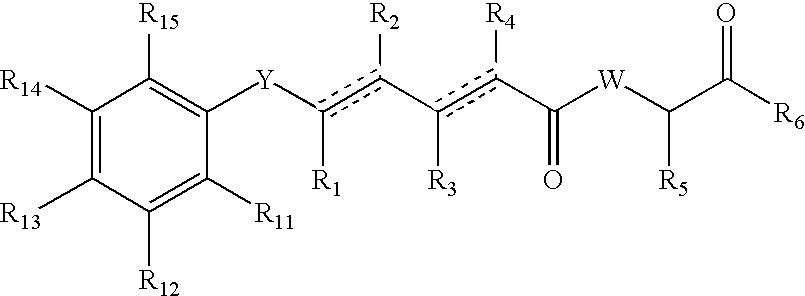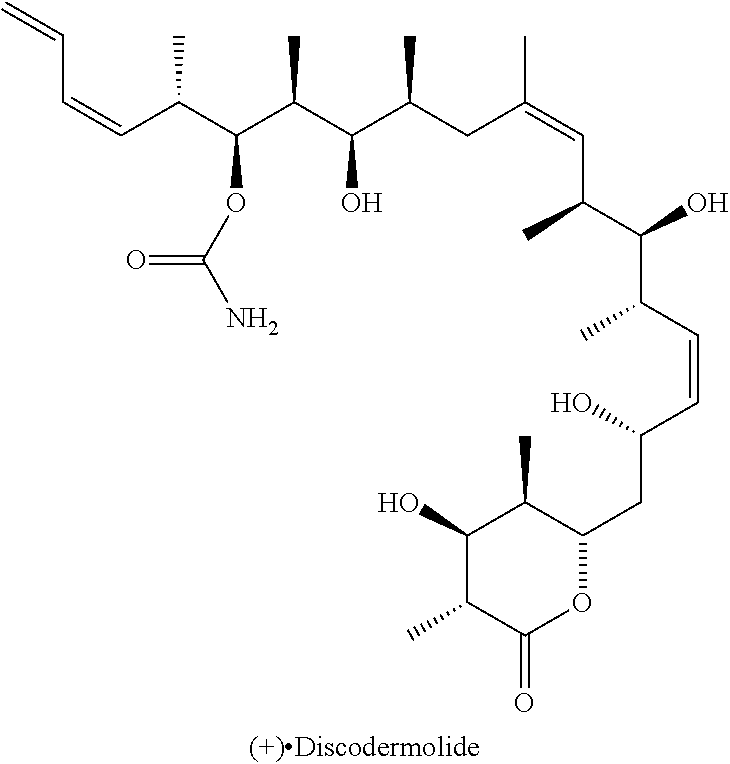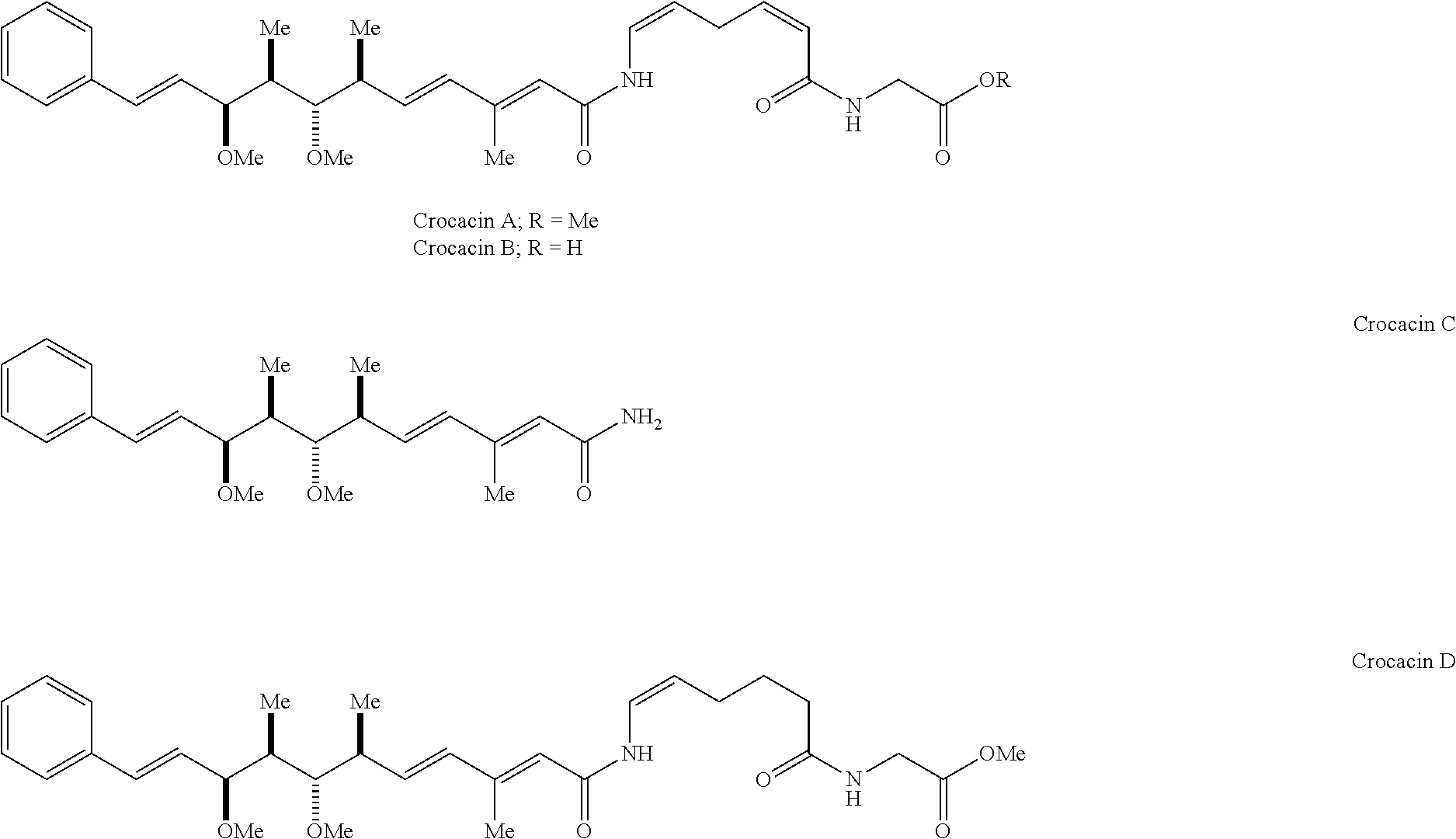Antitumoral Compounds
a technology of antitumoral compounds and compounds, applied in the field of new antitumoral compounds, can solve the problems of cancer being the leading cause of death in animals and humans
- Summary
- Abstract
- Description
- Claims
- Application Information
AI Technical Summary
Benefits of technology
Problems solved by technology
Method used
Image
Examples
example1
Synthesis of Fragments 12 and 13
[0089]Scheme 1 provides an example of the synthesis of fragments 12 and 13.
Synthesis of Intermediate 2
[0090]
[0091]To a solution of intermediate 1 (72.3 g, 0.39 mol) in anhydrous DCM (918 mL) at room temperature 3-Chloroperbenzoic acid (m-CPBA) (100 g, 0.58 mol) was added portionwise, and the mixture was stirred at room temperature for 18 h. The white precipitate was quenched with saturated aqueous solution of NaHCO3, extracted with DCM (3×250 mL) and washed again with saturated aqueous solution of NaHCO3 (3×250 mL). The organic layers were combined, dried over anhydrous Na2SO4 and concentrated in vacuo. The resulting oil was purified on silica gel (Hexane-EtOAc; 15:1) to provide epoxide as a colourless oil (64.5 g, 82%). To a solution of racemic epoxide (30 g, 0.15 mol) in anhydrous THF (7.5 mL) (R,R)-(−)-N,N′-Bis(3,5-di-tert-butylsalicylidene)-1,2-cyclohexanediaminocobalt(II) [(R,R)Co(II) complex] (448 mg, 0.74 mmol) was added, followed by AcOH (0.14...
example 2
Synthesis of Fragment 18
[0153]Scheme 2 provides an example of the synthesis of fragment 18.
Synthesis of Intermediate 14
[0154]
[0155]To a solution of 4-hydroxy-3-methoxybenzaldehyde (1 g, 6.57 mmol) in anhydrous DCM (14 mL), under N2 atmosphere and at 0° C., imidazole (1.118 g, 8.21 mmol) and tert-Butyldimethylsilylchloride (1.084 g, 7.22 mmol) were added. After 3 hours at room temperature the reaction was quenched with a solution of HCl 0.5N and diluted with CH2Cl2 (100 mL). The combined organic layers were washed with a saturated aqueous solution of NaHCO3 and brine. The organic phase was dried over anhydrous Na2SO4, filtered, and concentrated to afford 1.71 g (yield: 98%) of aldehyde 14.
[0156]1H NMR (CDCl3, 300 MHz) δ: 9.84 (s, 1H), 7.40-7.36 (m, 2H), 6.96 (d, 1H, J=7.8 Hz), 3.87 (s, 3H), 1.00 (s, 9H), 0.19 (s, 6H).
Synthesis of Intermediate 15
[0157]
[0158]Over a solution of aldehyde 14 (1 g, 3.75 mmol) in toluene (20 mL) Carboethoxyethylidene-triphenylphosphorane (3.4 g, 9.38 mmol) ...
example 3
Synthesis of Fragment 22
[0169]Scheme 3 provides an example of the synthesis of fragment 22.
Synthesis of Intermediate 19
[0170]
[0171]Over a solution of Phenylacetaldehyde (100 mg, 0.83 mmol) in toluene (5.0 mL) Carboethoxyethylidene-triphenylphosphorane (754 mg, 2.08 mmol) was added and the mixture was stirred at room temperature over 18 h. Then, the solvent was removed under reduced pressure and the resulting oil was purified by column chromatography (Ethyl acetate / hexanes mixture) affording pure 150 mg (90% yield) of ester compound 19.
[0172]1H NMR (CDCl3, 300 MHz) δ: 7.35-7.18 (m, 5H), 6.94 (t, 1H, J=7.5 Hz), 4.20 (q, 2H, J=7.2 Hz), 3.54 (d, 2H, J=7.8 Hz), 1.97 (s, 3H), 1.29 (t, 3H, J=7.2 Hz).
Synthesis of Intermediate 20
[0173]
[0174]Over a −78° C. cooled solution of ester 19 (150 mg, 0.73 mmol) in anhydrous THF (3.6 mL) under N2 atmosphere, Diisobutylaluminum hydride (DIBAL) 1M in toluene (1.62 mL, 1.62 mol) was added over a period of 5 min and the mixture was stirred at −78° C. Afte...
PUM
| Property | Measurement | Unit |
|---|---|---|
| temperature | aaaaa | aaaaa |
| temperature | aaaaa | aaaaa |
| temperature | aaaaa | aaaaa |
Abstract
Description
Claims
Application Information
 Login to View More
Login to View More - R&D
- Intellectual Property
- Life Sciences
- Materials
- Tech Scout
- Unparalleled Data Quality
- Higher Quality Content
- 60% Fewer Hallucinations
Browse by: Latest US Patents, China's latest patents, Technical Efficacy Thesaurus, Application Domain, Technology Topic, Popular Technical Reports.
© 2025 PatSnap. All rights reserved.Legal|Privacy policy|Modern Slavery Act Transparency Statement|Sitemap|About US| Contact US: help@patsnap.com



